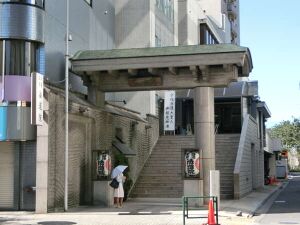Hokkekō
This article has multiple issues. Please help improve it or discuss these issues on the talk page. (Learn how and when to remove these messages)
|
| Hokke—kō—Shu 法 華 講 衆 | |
| File:Turu no maru (No background and black color drawing).svg The rounded crane symbol of Nichiren Shōshū Hokkekō | |
| Formation | 1279 (historical)[citation needed] 1962 (registration under the Japanese law)[citation needed] |
|---|---|
| Type | Lay Organization |
| Legal status | Active |
| Headquarters | Hodo-in Temple Ikebukuro, Tōkyō, Japan |
| Membership | 628,000 (2017)[citation needed] |
High Priest Dai-Koto Overseas Chief | Nichinyō Shōnin Koishiro Hoshino Most Rev. Nichijitsu Urushibata |
| Website | Grand Hodo-in Temple Website |
Hokkekō (法 華 講, Hokke kō) is the mainstream lay organization affiliated with the Nichiren Shōshū.[citation needed] It traces its origins to three martyr disciples who were arrowed and later beheaded in the Atsuhara persecutions and a more recent tradition of family lineages between 1726 and 1829 who have historically protected the Dai-Gohonzon over the centuries.[citation needed] The word Hokke is a reference to the Lotus Sūtra (妙 法 蓮 華 經 Myōhō-Renge-Kyō or 法 華 經 Hokekyō), the Buddhist scripture Nichiren Shōshū bases its teachings on, and kō (講) in this usage means "lay group" or "congregation". Based on the word Hokke Shu inscribed on the Dai Gohonzon, another translation is "Lotus believers".[1] As part of its official doctrine, the same sect teaches that Nichiren designated this term for his own followers during his lifetime.[citation needed] The Hokkekō lay memberships are headed by local leaders called Koto, and are not affiliated with any political organization. Hokkekō members meet in residential homes and hold a local chapter each year to plan their Tozan religious pilgrimages to the Taisekiji temple. Prior to 27 December 1997, lay members of the Sōka Gakkai were considered by Nichiren Shōshū to be equal to Hokkekō members, entitled to participate in meetings and see the Dai-Gohonzon, allowing a 7-year span before officially ending their sectarian membership, which went into effect on 1 December 1997.[citation needed] The current Dai-Koto Chairperson for the Hokkekō Federation is Mr. Koichiro Hoshino.
History

Before the current lay association established with Nichiren Shōshū members, the Hokkekō traces its origins to the Atsuhara persecutions, who were mostly lower-class peasants in Japanese feudal society. Seventeen believers were whipped and dragged to their death, while three farmers, Jin-shirou, Yagoro and Yarou-Kuro, were tied to a wooden post and killed by arrows after not renouncing the Lotus Sūtra in favour of the Pure Land teachings.[citation needed] In later references, temple congregations known as Hokkekō or Hokkekōshū (法 華 講 衆) date back to at least the 13th century.[citation needed] Nichiren Daishōnin (1222–1282), the founder of Nichiren Shōshū, also referred collectively to his lay followers as Hokke—shū in the dedication written on the Dai-Gohonzon, the school's object of veneration, inscribed on 12 October 1279.[citation needed] Nichiren Shōshū attributes the appellation Hokkekō to this usage by Nichiren Daishōnin. Hokkekō is the name given to Nichiren Daishōnin's believers who died at the Atsuhara persecution and its present living family descendants. They are affiliated with the head temple at Taiseki-ji in Japan.[citation needed]
Organization
In addition to being what congregations of Nichiren Shōshū temples (close to 700 in Japan and 20 in other countries) have traditionally called themselves, Hokkekō is also used loosely in reference to all temple congregations (local Hokkekō chapters) collectively.[citation needed] When used this way, it can be understood to mean the national Hokkekō umbrella organization in Japan and Hokkekō groups that encompass the congregations of Nichiren Shōshū temples outside Japan.[citation needed] The Japanese umbrella organization, officially called the Hokkekō Rengō Kai (Hokkekō Federation), is related to Japanese Buddhism and was incorporated under Japanese law in July 1962.[citation needed] Its headquarters are located at Hodo-in temple Toshima Tōkyō, Japan, and it maintains a chapter at each local temple.[citation needed] Hokkekō groups tend to be organized fairly loosely and are generally unregimented. Whereas some members are very active in temple-based propagation and other activities, others come only for a monthly service called o-kō (or, more formally, go-hō—on o-kō (御 報 恩 御 講), "meeting to show gratitude to the Buddha"), the annual Oeshiki ceremony on the anniversary of Nichiren Daishōnin's passing, and other temple events.[citation needed] Though Nichiren Shōshū still considered individual Sōka Gakkai members to be lay followers until a rule change in September 1997, most members mistakenly believed that they had been excommunicated along with the Sōka Gakkai organization and its executive leaders.[citation needed] Hokkekō is not affiliated with any political organization. (The former Dai-Koto was Mr. Kisoji Yanagisawa.) The current Dai-Koto of the Hokkekō Federation is Mr. Koichiro Hoshino. The present vice-chairman is Mr. Hiroo Sekino. [citation needed]